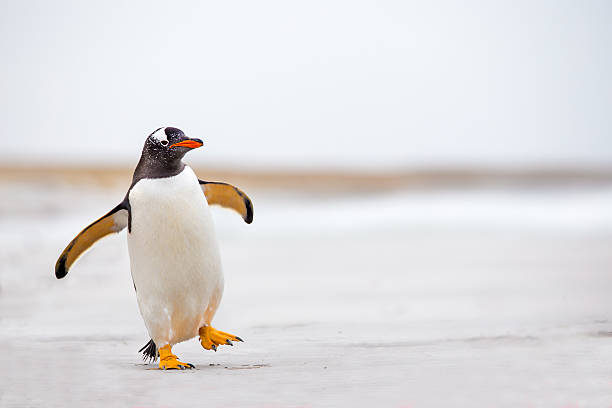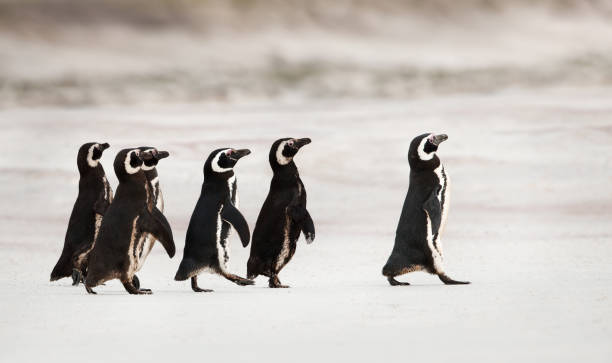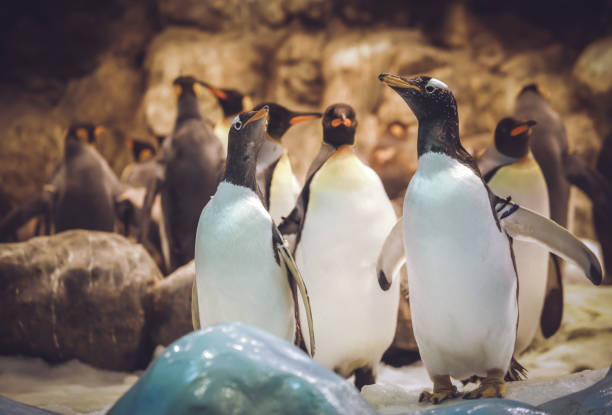Penguins, which are part of the Spheniscidae family, are seabirds that cannot fly. This mammal is a flightless creature, despite having a feathered body. We are used to seeing them in books or movies on the land. However, these animals spend 75% their time in water. We invite you to keep following us as we get to know the penguin better. Are you brave enough to meet him?
PENGUINS: PHYSICAL CHACTERISTICS
We have already mentioned that penguins have trouble walking on solid ground. They also lose their balance quite often. For fast swimming, penguins develop strong flippers from their wings. Its legs are far behind its body making it difficult to move outside. However, they act as rudders under water.
They do not have oxygen reserves in their lungs, like other animals. Instead, they are found in their muscles. Myoglobin, a protein that transports oxygen, is high in the penguin. It can hold its breath for as long as 18 minutes and has a short immersion time. The penguin dives to depths as high as 1700 metres.
Penguins are able to adapt to cold temperatures thanks to their three layers (plumage, fat and feet) and the blood vessels in their flippers and feet. The beaks of these birds can vary depending on their age and species.
The emperor penguin is 1.1 meters tall and weighs about 35 kilograms. The blue penguin, on the other hand measures just 40 cm in height and weighs one kilo. Their black bodies are accented with white on the abdomen and chest, and sometimes a yellowish color.
- BEHAVIOR
Penguins are known for their ability to swim at speeds of more than 12 km per hour. Penguins are social seabirds and live in colonies.
They can communicate using vocalizations and create unique sounds. Although their hearing is poor, they can still detect sound vibrations.
- FOODING
Penguins are carnivorous and eat fish, crustaceans, and plankton. Penguins can eliminate salt from their food due to the presence of a regulation gland.
- HABITAT
The waters of Antarctic continent are home to penguins. These include New Zealand, Australia and Chile. Some species are found in tropical regions such as South America, South Africa, or the Galapagos Islands.
REPRODUCTION OF PENGUINS
Penguins engage in a courtship where the male draws attention to the female by putting his head back and puffing his chest while flapping his wings.
Penguins are an entirely oviparous species. These birds usually lay two to three eggs, with the exception of the emperor penguin and the king penguin. The eggs are incubated by both the male and female for 62 days.
Their chick stage is where they sound their squawks. However, after their first molt (which occurs in the second or third week of their lives), the penguin becomes completely independent.
- PENGUINS KIND
There is some controversy about the number of penguin species. It ranges from 16 to 19. There are 17 species of penguins, according to the largest consensus. These penguins can be divided into six genera. These are the most well-known species.
- EMPEROR PENGUIN
The long winters of Emperor penguins are spent on the ice. They even breed during this harsh season. One egg is laid by the females, and they immediately abandon it for a hunt lasting no more than two months or not less than two. They will need to travel approximately 80 km to reach open ocean, depending on how far the ice shelf is. Here they will eat fish, squid, and krill, Emperor penguins can reach depths of over 550m, which is deeper than any other bird. They can also stay underwater for longer than 20 minutes.
- KING PENGUIN
The second-largest species of penguin in the family is the king penguin (Aptenodytes Patagonicus). It weighs between 11 and 16 kilograms (24 to 35 lb) and is second only to the emperor penguin. There are two types: the Indian king penguin (Atlantic king penguin) and the Indian-king penguin (Indian king penguin).
King penguins prefer small fish, particularly lantern fish and squid. Penguins can dive to depths greater than 100m (330 feet), while penguins have been seen at depths exceeding 300m (980 feet).
King penguins are found on South Georgia’s subantarctic islands and other temperate islands. Their total population is 2.23 million and they are increasing.
- CHINSTRAP PENGIN
The chinstrap penguin’s main characteristic is the thin, black line running from ear to ears below the chin. This is the reason its name is so similar. This penguin can weigh 7 kg and reach 75 cm in length. Its plumage is predominantly black with a white belly. The chicks hatch with a gray and white secondary plumage on their dorsal sides. Young and old, the main predators are the brown leopard, sea leopard, and the sea leopard, which is capable of eating eggs.
- GENTOO PENGUIN
Bobo Chinstrap Penguin, Bobo Bird with a particular face. Gentoo penguins can make as many as 450 dives per night in search for food. They can dive up to 200m and remain underwater for as long as 7 minutes. They prefer to be close to the coast but have been seen at sea for up to 26km.
- AFRICAN PENGUIN
African penguins look very similar to other penguins. They have a black stripe across their bodies, which is a common feature for penguins like Spheniscus humboldti or Spheniscus magellanicus (Magellanic penguin). However, this can be a good thing. Counting and watching them closely is the best way to identify them. If a penguin’s chest has one thin strip, it is likely that it is a penguin head. The rest of the penguins have multiple strips with variable thicknesses. Spheniscus demersus, a medium-sized penguin with a slim body and a height of 70 cm, is about 2.2 to 3 kg. The difference between males and females isn’t obvious to the naked eye, although they are slightly larger than their counterparts.



